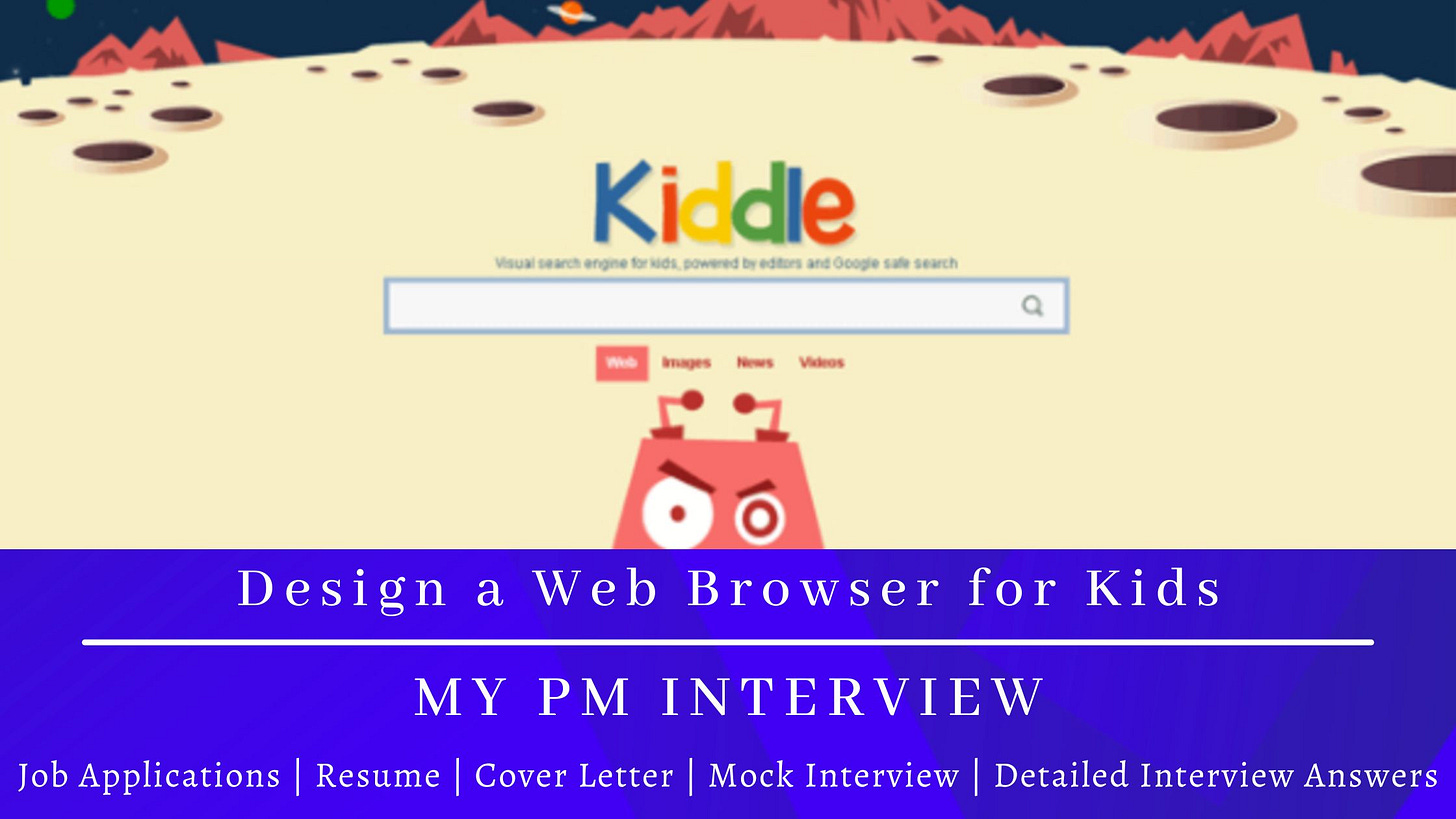Design a Web Browser for Kids
Google PM Interview: Product Design Question -Design a web browser for kids
Framework:
Here is a step-by-step framework, you should follow while answering product interview questions during your interview:
1. Ask clarifying Questions to trim down the scope of the question
2. Define the Goal you want to achieve
3. List the User Segments and select one segment to focus on
4. List and prioritize the Pain Points for that segment
5. List out your Solutions to solve those pain points
6. Evaluate all the solutions and prioritize them
7. Define Metrics to measure the performance of the solutions
8. Plan the GTM for it
9. At the end, Summarize your answer
Clarifying Questions
Do we focus on all children under 18 or a subset (e.g. pre‑school vs. teens)?
Which countries or languages to focus on?
Will it include social media, messaging, educational sites, games?
Are there any content categories to emphasize or exclude?
Is this a standalone browser (new engine) or a “kid mode” on existing browsers?
How is it funded? (free/download, paid subscription, ad‑supported, OEM-bundled on devices?)
Should we target schools or families directly?
What privacy/safety laws (e.g. COPPA) must we consider?
For example, do we allow extensions/plugins or just a locked-down environment?
Goal
The primary goal is to enable safe, engaging exploration of the web for kids while satisfying parents’ safety requirements. In other words, let children benefit from the internet’s learning and entertainment opportunities, without exposure to harmful content or distractions. We also aim to build parental trust (e.g. by providing reassurance and control) and to create a product that children will enjoy using (so they voluntarily use it for homework or fun). Ultimately success means high adoption and retention in our target segment, with kids using the browser confidently and parents feeling secure about their child’s online activity.
User Segments
Possible user segments include:
Young children (ages 3–5): Pre-readers who need almost entirely visual guidance (icons, voice, videos).
Primary school kids (ages 6–8): Early readers who want games, videos, and help with homework.
Older kids (ages 9–12): Can read and search more independently, use for research and safe social apps.
Teens (13–17): More mature users who may want moderated autonomy (but often have smartphones/computers of their own).
Special-needs children: e.g. autistic or dyslexic kids who may need extra support (some products even target autistic children specifically).
According to usability research, it’s crucial to treat each age band separately.
For this exercise, we will focus on 9–17 year olds. This segment is tech‑savvy enough to use a browser on their own (often doing homework research or playing games), but still requires strong guidance. They also form a large market: most get their first phones or tablets between ages 9–17. We assume their parents are involved and concerned about safety.
Pain Points
Pain Points of Kids (Ages 9–17) While Using a Browser,
Standard browsers can expose kids to porn, violence, or disturbing sites without warning. This is parents’ #1 fear. Kids themselves may accidentally click a link and get scared or traumatised. Online predators, bullying, and privacy risks also loom large.
Children often can’t distinguish ads from real content. Intrusive ads, pop-ups or unrelated links can confuse or mislead them, leading to frustration or risk.
Most browsers are too “grown‑up.” Tiny buttons, lots of text, multiple menus and tabs can overwhelm a child. For example, Nielsen found kids need much larger tappable buttons (roughly 2cm) and simpler layouts. Young kids may avoid scrolling or not even understand standard icons (like the back arrow).
Kids may not phrase queries well, and normal search can show advanced or undesirable results. A 9–17 year-old may struggle to formulate searches or pick keywords, or may land on content above their reading level. Current kid-search tools (Kiddle, KidRex, etc.) help, but kids may still hit blocked pages or miss what they want.
Kids have short attention spans and want interactive feedback. If the browser experience isn’t fun or rewarding, they will switch to games/apps. Purely educational interfaces may bore them.
Both kids and parents struggle to self-regulate online time. Unlimited access can lead to excessive screen time; kids may also try to bypass restrictions (e.g. using VPN or another browser). Parents need tools to enforce breaks and sleep times.
If a child finds a way to exit the safe browser or disable controls, parents lose trust. Parents also feel uneasy if an app can lead their child “outside” the safe environment. They want assurance that nothing dangerous is a click away.
Solutions
Here are the solutions to the above-listed pain points,


